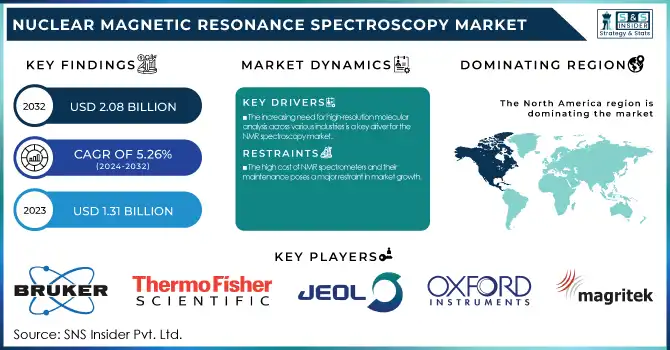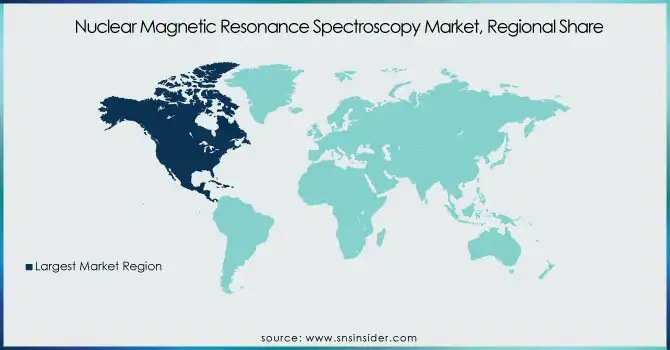Nuclear Magnetic Resonance Spectroscopy Market Size & Overview:
The Nuclear Magnetic Resonance Spectroscopy Market Size was valued at USD 1.31 billion in 2023 and is expected to reach USD 2.08 billion by 2032 and grow at a CAGR of 5.26% over the forecast period 2024-2032. This report identifies adoption and usage patterns, with a focus on the growing demand for NMR in pharmaceutical research, material science, and diagnostic use. The research investigates technological developments, such as greater field strength instruments and enhanced data processing methods, in addition to increasing research and academic funding that drives innovation in spectroscopy use. It also investigates cost and pricing patterns, considering the effect of instrument affordability, maintenance costs, and accessibility of funding on market growth. The report also reviews how these trends collectively impact the changing dynamics of the NMR Spectroscopy market.

To Get more information on Nuclear Magnetic Resonance Spectroscopy Market - Request Free Sample Report
Nuclear Magnetic Resonance Spectroscopy Market Dynamics
Drivers
-
The increasing need for high-resolution molecular analysis across various industries is a key driver for the NMR spectroscopy market.
Pharmaceutical and biotechnology industries utilize NMR in depth for drug development, biomarker discovery, and quality analysis, making their research more efficient. The increasing incidence of chronic diseases has heightened the need for cutting-edge spectroscopic methodologies in structural biology and metabolomics. Moreover, the food industry utilizes NMR spectroscopy for food safety, detection of contaminations, and authenticity testing, complying with rigorous regulatory guidelines. The development of benchtop NMR spectrometers, presenting affordable and accessible options, is further accelerating adoption in small-scale research laboratories and industrial processes. Technological innovations, including high-field NMR systems above 1 GHz, are extending the frontiers of molecular study, enabling scientists to analyze intricate biological organizations with unprecedented accuracy. The combination of AI and automation for NMR data analysis is enhancing precision and minimizing processing time, bringing the technology within reach of more industries. As government and private sector funding for life sciences research continues to grow, demand for NMR spectroscopy is likely to accelerate, especially in drug development, personalized medicine, and chemical analysis applications.
Restraints
-
The high cost of NMR spectrometers and their maintenance poses a major restraint in market growth.
High-field NMR systems (over 600 MHz) are capital-intensive, costing more than USD 5 million, and thus out of reach for most small research laboratories and academic institutions. The expense of superconducting magnets, which are needed for high-resolution imaging, adds to the overall cost. Cryogenic cooling systems and helium reliance drive up operational costs, with maintenance being costly and complicated. Limited availability of funds in developing countries hinders the extensive implementation of NMR spectroscopy due to the inability of numerous research centers and hospitals to purchase sophisticated spectrometers. A second major limitation is the need for highly trained personnel to run and analyze NMR data. Most analytical tools like mass spectrometry or chromatography do not demand special skills, but NMR demands specialized talent, usually out of reach for institutions with limited experienced personnel. Additionally, other spectroscopic techniques like Fourier Transform Infrared (FTIR) and Raman spectroscopy offer quicker and cheaper analytical options, competing with NMR in some applications. Even with advancements in benchtop NMR technology, low-field systems are constrained by sensitivity and resolution, limiting their application in high-precision research areas like drug discovery and structural biology.
Opportunities
-
The growing adoption of NMR spectroscopy in clinical diagnostics and environmental monitoring presents significant market opportunities.
NMR is becoming an important tool for the early detection of disease, metabolic profiling, and personalized medicine. Its potential to deliver non-invasive, high-resolution metabolic fingerprints is being investigated in fields such as cancer research, neurodegenerative diseases, and metabolic disorders. The combination of NMR with artificial intelligence (AI) and machine learning is also broadening its application in predictive analytics for healthcare. In addition, the growing emphasis on environmental monitoring and sustainability is propelling demand for NMR spectroscopy in water quality testing, soil analysis, and the detection of environmental contaminants. The technology's capability to examine contaminants without sample destruction makes it suitable for regulatory and industrial monitoring. The creation of miniaturized and transportable benchtop NMR systems is unveiling new applications in on-site testing and real-time industrial quality control, especially in food safety, agriculture, and petrochemical industries. Increasing collaboration between academic institutions and industry players is also driving innovation, resulting in affordable solutions and better accessibility of NMR spectroscopy. With more government and private funding support, commercialization of low-cost NMR solutions would further boost its take-up by emerging markets.
Challenges
-
One of the major challenges in the NMR spectroscopy market is the global helium shortage, which directly impacts the operation of high-field NMR spectrometers.
Liquid helium is used for cooling superconducting magnets, and supply restrictions have resulted in variable availability and increasing prices, impacting research facilities and industries using NMR technology. Other technologies for cooling like cryogen-free magnets are also under investigation, but extensive implementation is hindered due to heavy R&D expenditures. Another issue is the lack of standardization of NMR data interpretation between industries and areas of research. In contrast to mass spectrometry, with established databases for molecular identification, NMR spectral libraries tend to be incomplete and hence difficult to interpret consistently. Moreover, the complexity of multi-dimensional NMR methods necessitates highly trained manpower, which prevents it from reaching non-experts. The time-consuming analysis as compared to other spectroscopy methods is another obstacle, as industries require quicker and more automated analysis solutions. The lag in the clinic's adoption of high-field NMR owing to regulatory barriers constrains its future growth in the healthcare industry further. Technology innovation, greater investment in cryogen-free equipment, and standardized analytical methods will be needed to overcome these challenges and enhance data reliability and efficiency.
Nuclear Magnetic Resonance Spectroscopy Market Segmentation Insights
By Product
The instruments segment led the NMR spectroscopy market with a strong share of 80.3% in 2023. This leadership is mainly fueled by the exorbitant price of NMR spectrometers, growing use in research institutes and academic institutions, and ongoing technological innovation in high-field and benchtop NMR systems. The need for high-resolution imaging and molecular analysis has also increased the growth of this segment.
Conversely, the consumables segment will experience the fastest growth over the forecast period. The increasing demand for deuterated solvents, NMR tubes, and other critical reagents for diagnostic and analytical purposes is driving its demand. Rising NMR applications in pharmaceutical research and quality control are further propelling the growth of this segment.
By Type
The high-field NMR spectroscopy segment dominated the market with a commanding 88.7% share in 2023. This is because it has superior sensitivity, excellent resolution, and widespread application in structural biology, pharmaceutical research, and sophisticated material science applications. High-field NMR systems are essential for the analysis of complex molecules and, hence preferred in academic and industrial research.
At the same time, the low-field NMR spectroscopy segment is anticipated to expand at the highest growth rate. Growing demand for compact, affordable, and easy-to-use NMR systems in food analysis, agriculture, and routine industrial processes is fueling its uptake. Its expanding application in quality control and real-time monitoring is also contributing to its growth.
By End Use
The academic segment led as the primary end-use segment, holding a market share of 46.9% in 2023. The large-scale application of NMR spectroscopy in research programs at universities, structural biology, and studies in molecular chemistry has established it as the industry leader. Apart from this, growing government expenditures on academic research and the presence of well-developed research institutes across the world have also given a boost to the demand for NMR devices in this space.
On the other hand, the food and agriculture sector is anticipated to experience the fastest growth during the forecast period. The increasing demand for food safety testing, quality assurance, and authenticity analysis has fueled the use of NMR spectroscopy in the industry. The technology's capability to deliver non-destructive and comprehensive molecular information on food composition and contaminants is fueling its uptake in agricultural and food applications.
Nuclear Magnetic Resonance Spectroscopy Market Regional Analysis
The North American market led the NMR spectroscopy market in 2023, led by robust research funding, presence of key industry players, and widespread use in pharmaceutical and biotechnology research. The United States is particularly dominant, with high usage rates in academic and pharmaceutical R&D and large investments in advanced NMR technology.
Europe followed closely, with Germany, the UK, and France among the leading market players. Europe is supported by a strong research infrastructure, collaborations between industry stakeholders and academic institutions, and government incentives for life sciences and material science applications. Increasing demand for high-field NMR in metabolomics and structural biology further secures Europe's market position.
The Asia-Pacific region is anticipated to experience the highest growth during the forecast period, driven by growing investments in research facilities, growing pharmaceutical and biotech sectors, and growing applications in food safety and agriculture. China, Japan, and India are among the most important contributors, with China experiencing swift developments in NMR-based research and industrial uses. Government efforts to promote scientific research and growing partnerships with international players further boost market growth.

Get Customized Report as per Your Business Requirement - Enquiry Now
Key Players and Their Products in the Nuclear Magnetic Resonance (NMR) Spectroscopy Market
-
Bruker Corporation – AVANCE NEO, Fourier 80, BioSpin
-
Thermo Fisher Scientific Inc. – picoSpin Series
-
JEOL Ltd. – JNM-ECZ Series, JNM-ECZR Series
-
Oxford Instruments – MQC+ Benchtop NMR Analyzers, Pulsar Benchtop NMR
-
Nanalysis Corp. – 60PRO, 100PRO, NMReady-60
-
Magritek – Spinsolve Series
-
Niumag Corporation – MicroMR Series, MacroMR Series
-
QoneTec AG – NMR Probes & Accessories
-
Cosa Xentaur – Benchtop NMR Systems
-
Anasazi Instruments, Inc. – Eft-60 NMR, Eft-90 NMR
-
Buck Scientific – NMR Spectrometers
-
Tel Atomic Incorporated – Educational NMR Systems
-
TecMag – Redstone NMR Spectrometers
Recent Developments
In Dec 2024, Bruker announced the acceptance of a 1.2 GHz Ascend NMR spectrometer at the Swiss High-field NMR Facility, operated by the University of Basel, ETH Zürich, and the University of Zürich. Installed at the University of Zürich, this advanced instrument will enhance research in structural biology and macromolecular analysis. It is the second 1.2 GHz NMR in Switzerland, complementing the first at ETH Zürich, which focuses on solid-state NMR, material studies, and biological research.
| Report Attributes | Details |
|---|---|
| Market Size in 2023 | USD 1.31 billion |
| Market Size by 2032 | USD 2.08 billion |
| CAGR | CAGR of 5.26% From 2024 to 2032 |
| Base Year | 2023 |
| Forecast Period | 2024-2032 |
| Historical Data | 2020-2022 |
| Report Scope & Coverage | Market Size, Segments Analysis, Competitive Landscape, Regional Analysis, DROC & SWOT Analysis, Forecast Outlook |
| Key Segments | • By Product [Instruments, Consumables] • By Type [Low-field NMR spectroscopy, High-field NMR spectroscopy] • By End Use [Academic, Pharmaceutical & Biotech companies, Agriculture and Food, Chemical Industries, Others] |
| Regional Analysis/Coverage | North America (US, Canada, Mexico), Europe (Eastern Europe [Poland, Romania, Hungary, Turkey, Rest of Eastern Europe] Western Europe] Germany, France, UK, Italy, Spain, Netherlands, Switzerland, Austria, Rest of Western Europe]), Asia Pacific (China, India, Japan, South Korea, Vietnam, Singapore, Australia, Rest of Asia Pacific), Middle East & Africa (Middle East [UAE, Egypt, Saudi Arabia, Qatar, Rest of Middle East], Africa [Nigeria, South Africa, Rest of Africa], Latin America (Brazil, Argentina, Colombia, Rest of Latin America) |
| Company Profiles | Bruker Corporation, Thermo Fisher Scientific Inc., JEOL Ltd., Oxford Instruments, Nanalysis Corp., Magritek, Niumag Corporation, QoneTec AG, Cosa Xentaur, Anasazi Instruments, Inc., Buck Scientific, Tel Atomic Incorporated, TecMag. |

